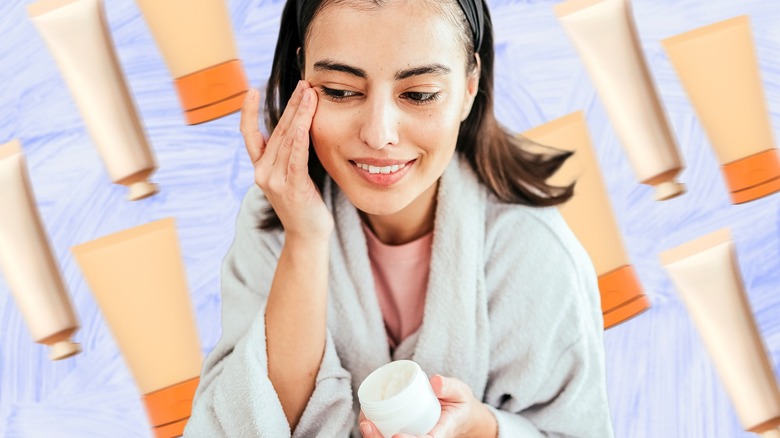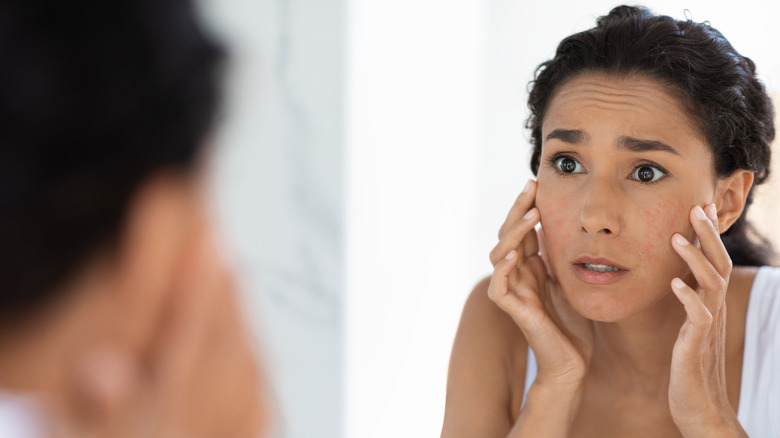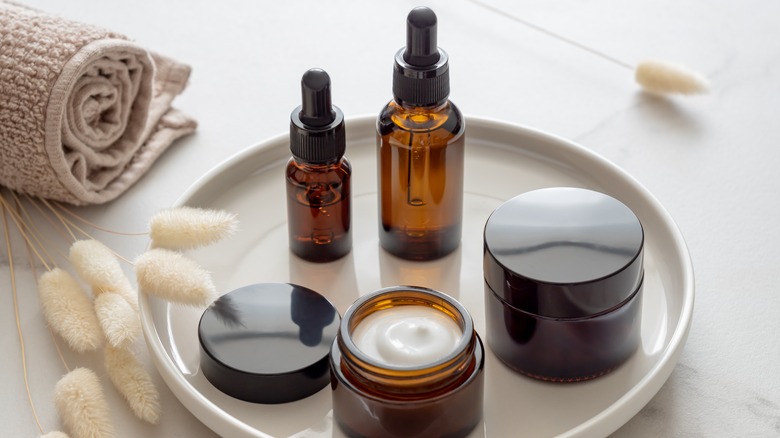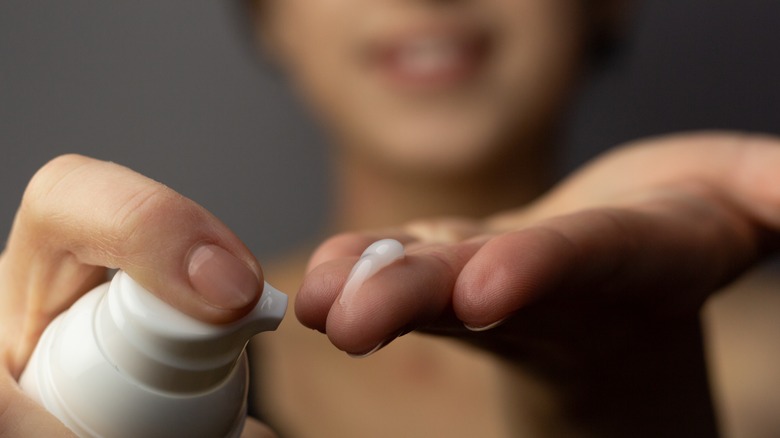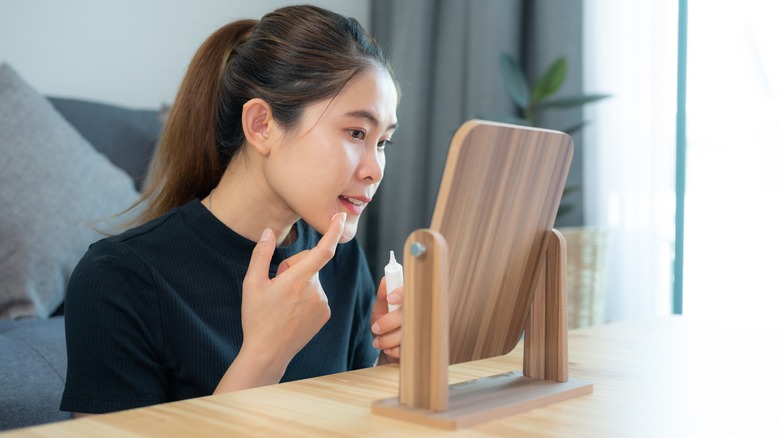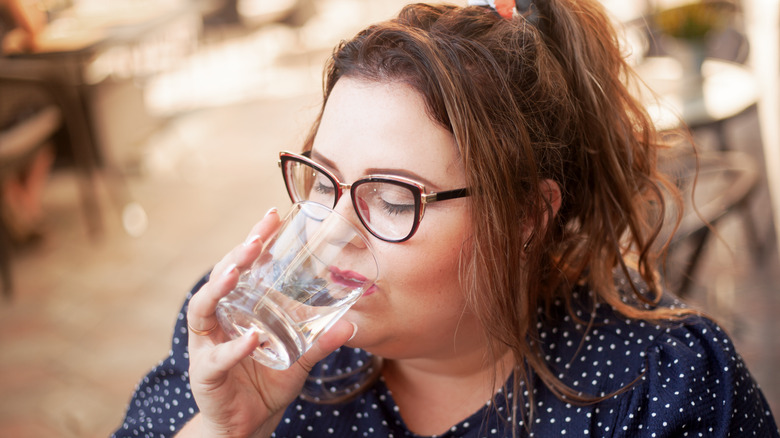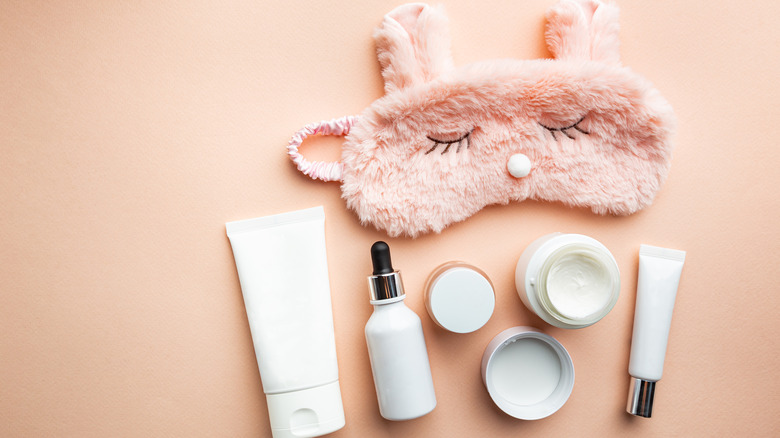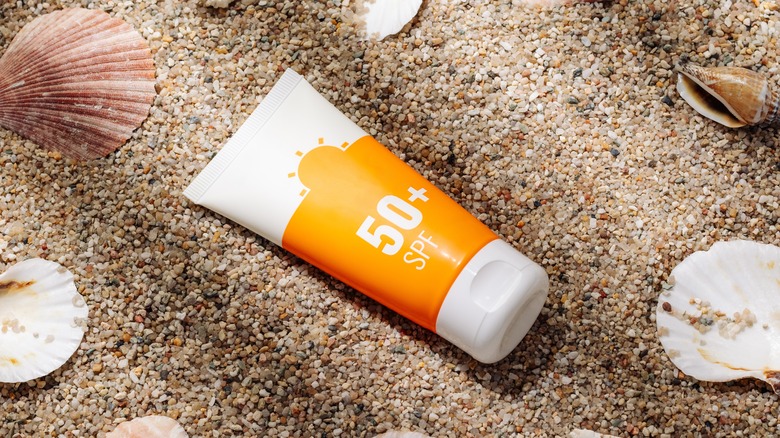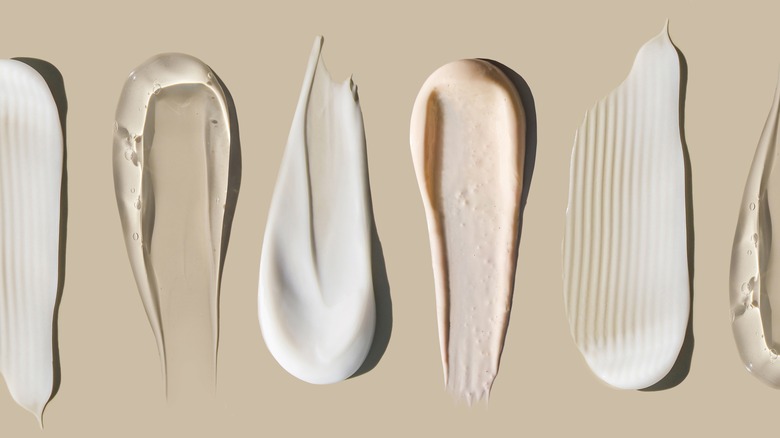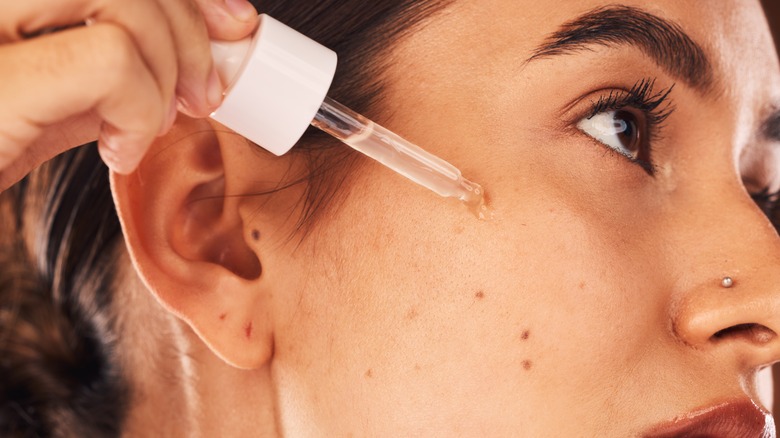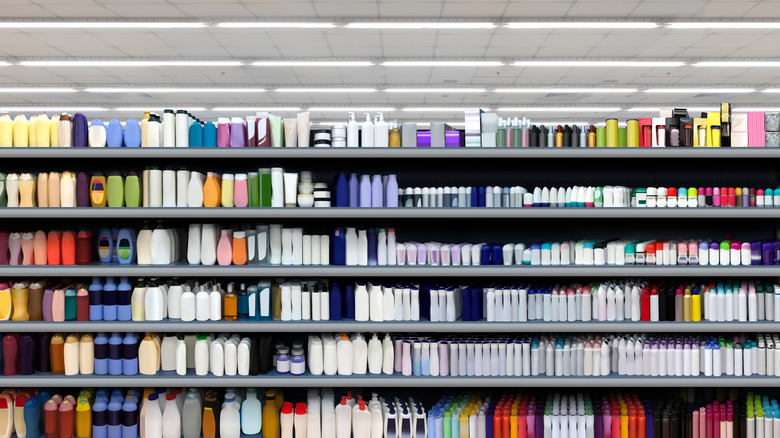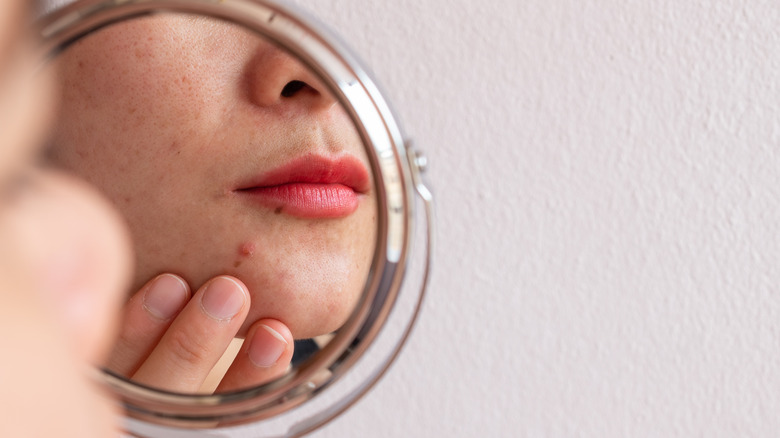How To Keep Your Skin Hydrated When Using Tretinoin
From simple eye creams to serums and face masks, the skincare industry is as diverse as it is lucrative. Whether you're looking for a remedy for under-eye dryness, a treatment for milia, or a fragrance-free lotion, there is a product out there intended to treat every skin issue you can think of. One product known for its effectiveness in treating acne and evening out skin texture is tretinoin. Sometimes known as Retin-A or trans-retinoic acid, tretinoin is prescribed by doctors as a topical cream due to its strength. In recent years, it has garnered praise and is described by some as the holy grail for acne prevention and anti-aging.
Like many strong skincare products, however, one major issue associated with taking tretinoin is dryness. As a retinol product, tretinoin can make keeping your skin hydrated a challenge. This is often one of the reasons people are reluctant to start using tretinoin, although it is effective at treating acne. Despite this, you can still have healthy, hydrated skin while using this topical cream if you're aware of what to do if your skin gets dehydrated. Popular with skincare gurus and doctors alike, if applied correctly it is possible to both fight your acne with tretinoin and keep your skin healthy and well hydrated.
Tretinoin and hydration
While moisturizing often goes hand in hand with using other acne products such as Differin, benzoyl peroxide, and Accutane, much of the discussion around tretinoin is focused on how especially important hydration is when using it. But why is it so important? A lot of the redness, dryness, and peeling labeled as severe dehydration when using tretinoin is actually a side effect known as retinization, or retinol burn – the period between beginning a retinoid and your skin becoming accustomed to a new product, per Healthline.
If you're not keeping up with your hydration or enjoying a regular moisturization schedule, this retinization is difficult to cope with and can become extreme when using a high-strength product like tretinoin. However, these side effects are manageable if you stick with a moisturizing routine. "Almost everyone can use retinoids if you tailor it to yourself," professor of dermatology Dr. Jenny Kim told Self. Similarly, a 2019 study by Pharmaceutics found that regular moisturization can help to prevent the drying effects associated with repeated tretinoin use.
Before you apply tretinoin
To ensure your skin stays hydrated while using tretinoin, the best plan of action is to think ahead and get educated on how best to protect your skin. Online skincare communities can be a great way to get advice from those who've been through the tretinoin process already. Sites such as TikTok and Instagram can be helpful if you're a beginner wanting some extra info on this trendy skincare remedy, with videos by users like @4complexion providing helpful advice on introducing tretinoin to your routine.
However, if you are concerned about potentially damaging your skin or not sure how to maintain a good routine, consulting with a professional is probably the best bet. As well as giving general skincare advice, a dermatologist will be able to diagnose and help treat any severe side effects from tretinoin. They can also help advise you on how to prevent dehydration before you start using tretinoin and avoid severe side effects in the first place. In general, if you have long-term skin issues or severe acne, it's wise to seek professional medical advice.
Moisturize before applying
So you've gotten your tretinoin and you're ready to start adding it into your skincare regimen — but where should moisturizing fit in? Generally, you should be applying your tretinoin to clean, dry skin, although whether or not you should moisturize before or after tretinoin really depends on your needs.
For beginners just starting tretinoin or anyone with sensitive skin, moisturizing beforehand is recommended. This helps to create a protective layer against irritation before the harsher retinoid is applied. The specific moisturizer you use is up to you. "Generally, you may find you need a more hydrating moisturizer with a cream or gel base to help combat flaking or dryness, especially in the winter months," dermatologist Dr. David Lortscher explained to Bustle. However, if your skin is fairly resistant or you've been using tretinoin for a while, feel free to apply it before moisturizing. Overall, the most important thing is that you are moisturizing in some shape or form, so don't worry too much if you switch up the application order every so often based on your skin's particular needs.
Start with a low-strength dose
While tretinoin is often referred to as just that, there are, in fact, multiple variations of this topical cream. The strengths you can be prescribed by a doctor range from 0.01% to 0.1%, though some branded versions of tretinoin such as Retin-A can be found at slightly different strengths. While higher concentrations are overall stronger, this doesn't necessarily mean jumping to 0.1% is the most effective strategy to heal your acne. "In both clinical trials and my personal experience with patients, higher retinol concentrations of more than 0.5 percent have not shown to be more effective," skincare expert Dr. Simran Sethi said to Martha Stewart.
As well as this, choosing a lower dosage can be a good way to get your skin used to this retinoid, or treat milder forms of acne with less risk of causing extreme dryness. Similarly, over-irritation and redness can be avoided by applying your tretinoin less frequently to begin with. Some people find applying their cream every other day before moving to more frequent application once their skin becomes accustomed to it to be the solution to avoiding irritation.
Apply a small amount of tretinoin
When applying a new skincare product, it can be tempting to want to apply as much as possible to ensure it can quickly get to work on your acne. However, with tretinoin, the recommended advice for applying this product is that less is more. In terms of dosage, a pea-size amount only should be applied at a time, per dermatologist Dr. Alpana Mohta.
Tretinoin should also not be used on every part of your face. Although it's intended to treat facial acne, you should try and avoid applying it around your ears, eyes, lips, and nostrils if possible. Applying only a little of the product at a time is also a good way to avoid serious irritation or accidentally applying it to clear parts of your face and wasting it.
Drink your water
While drinking water is good for your body in general, it can also be a small help when starting a particularly strong skincare treatment such as tretinoin. Although not a replacement for direct moisturization, drinking a healthy amount of water may help your skin stay plump and glowy. A 2015 study by Clinical, Cosmetic and Investigational Dermatology found that the overall appearance of skin improved when participants were prompted to drink more water.
Despite this, it's important to note that drinking more water can't cure dry skin nor treat extreme dryness caused by retinization via tretinoin. "There's no data to support the idea that drinking a glass of water helps hydrate the skin," dermatologist Dr. Joshua Zeichner discussed with Byrdie. "On the other hand, there's no data to show that drinking fewer than eight glasses of water per day is harmful." Overall, remembering to drink a glass of water every so often isn't a miracle cure for acne but is still a good habit for your overall well-being, and a useful tip to keep your skin in tip-top shape.
Leave your tretinoin on for the right amount of time
So now you've applied your tretinoin the right way, using the proper amount, and given your face some added moisturizing to help combat any dryness — but how long should you be leaving it on for? If you're new to tretinoin, the general recommendation is to leave the cream on your face for a few hours every other day.
Once accustomed to this retinoid, you can move to daily application and leaving your tretinoin on overnight. There's no specified length of time you should leave this retinoid on for, but as with any prescribed acne medication, less is more if you want to avoid irritation.
Always apply sunscreen
As well as keeping up with your moisturizing schedule, what you put on your face in between your morning and night routines is equally important. With the major side effect of using tretinoin being irritation, any exposure to the sun or getting a sunburn has the potential to be much more severe than usual.
According to Mayo Clinic, to avoid this, it's recommended that you apply sunscreen each day and aim to stay out of strong sunlight as much as possible, especially when beginning tretinoin for the first time. As retinoid use encourages skin cell turnover, you'll be at a higher risk of damage from UV rays and more serious sunburns, per acne.org.
How long should you use tretinoin?
While some products like cleansers, makeup removers, and moisturizers can be used indefinitely, using stronger products for extended periods can be more risky. However, many of these skincare solutions are intended to be used for long periods of time. On average, it's reported that tretinoin takes around three to six months to have a visible impact on acne. And there seems to be little to no risks if you decide to use tretinoin for months, or even years.
One study in 2005 by the American Journal of Clinical Dermatology found that tretinoin use for two years and onward showed no negative side effects. A similar study in 1996 by the Journal of Dermatological Science done over a longer period found that even after using tretinoin for four years, this topical cream was still able to remain effective in treating acne and boosting the overall appearance of irritation-prone skin. Like many skincare remedies on the market, the effectiveness of tretinoin when introduced as a new product to your routine may take a while to be beneficial, but it appears to be suitable for long-term use.
Tretinoin vs. retinol
In conversations about skincare, retinol and tretinoin are often paired together. Although they have similar benefits (both products help to boost skin cell turnover), there are some major differences between them. "'Retinoid' is essentially a basic umbrella term for both over-the-counter retinol and prescription retinoids," dermatologist and M.D. Melissa Kanchanapoomi Levin explained to Byrdie.
Both members of the retinoid family, regular retinol and a product such as tretinoin have different strengths. Thought to be up to 20 times stronger than the average retinol, tretinoin can only be found via doctor's prescription, while retinol is generally available commercially. While both products have similar effects, it's important to understand the differences between them regarding concentration to find the retinoid product that works the best for you.
Alternatives to tretinoin
Alongside tretinoin, there are a range of similar products and retinoid alternatives often lauded by skincare fans as being equally effective in dealing with persistent acne. If tretinoin isn't available to you, or you're concerned about potential irritation on your skin, these alternatives could be right for you.
Lotions containing benzoyl peroxide — such as Differin and Duac — provide similar acne management effects. Other popular topical retinoids include Tazorac and Epiduo. As always, it's important to check your ingredients before switching products to avoid mixing multiple types of retinoids or other harsh products together, and potentially causing a negative reaction.
The side effects of tretinoin
As a product often prescribed at a strong concentration, tretinoin can have negative side effects and cause concern for those wanting to use it. Common side effects include burning, itching, redness, and persistent dryness. These symptoms can also be the result of retinization. Similarly, your skin's negative reaction to tretinoin may actually be completely normal and a part of the temporary "purging" process this topical cream is supposed to cause.
"Skin purging refers to a reaction when an active ingredient increases skin cell turnover rate which can cause old skin to shed," dermatologist Dr. Nyla Raja told Elle. "This can lead to flakiness and dryness when first using retinol or an active ingredient." As always, consult with a dermatologist or medical professional if your skin doesn't seem to be getting used to tretinoin and getting out of the retinol purging phase, or is having a severe reaction to the cream.
